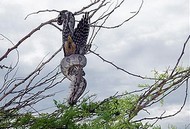Snakes “Boas” in Aruba are Impossible to Control … Metaphor
Posted in: Amigoe,Aruba,Bizarre,Crime,Deepak Kalpoe,Fun,Joran Van der Sloot,Missing Persons,Natalee Holloway
When describing a predatory snake, they all begin to sound the same. “They are not shy and they can hide themselves”. What or who is actually being discussed in this article, the comparisons are uncanny. Talk about your symbolism.
“We know that boas eat birds, but we didn’t know that they also attach birds of prey.” Even though the final report on the big boa-research is still pending, all the information is meanwhile in. From this information it appears that the boas in Aruba are very difficult to control. Not only are they shy, they can also hide themselves very well. What we do know is that snakes “in Aruba are very difficult to control”.
“But a boa also knows instinctively how to hide, which makes catching her very difficult, almost impossible”, says Curiel.
Amigoe; November 9, 2007: Impossible to control boas – Boa eats warawara
The hanging boa in this tree is savoring a warawara.
ORANJESTAD – Family Beijaard from Hoedekenskerke in the Dutch province Zeeland took this unique picture when they were on vacation in Aruba. They ran across this amazing sight at Seroe Colorado on October 27. Hanging of a tree branch, a strapping boa threw herself on a warawara (as this bird is called in Papiamento, or a kuifcaracara, the official name of this bird of prey) and ate it.
Ambrosio Curiel of Parke Nacional Arikok admits that this is a unique picture. “We know that boas eat birds, but we didn’t know that they also attach birds of prey.” Even though the final report on the big boa-research is still pending, all the information is meanwhile in. From this information it appears that the boas in Aruba are very difficult to control. Not only are they shy, they can also hide themselves very well. “We even had a lot of trouble finding the ones we have chipped. From the clear signal you receive, you would think that you ought to be almost on top of the snake, but you can still not see her. This is partly due to the perfect camouflage. But a boa also knows instinctively how to hide, which makes catching her very difficult, almost impossible’, says Curiel.
“The big ones are easier to catch and what are left are the smaller ones that are more difficult to find.” There is no way to find then when they are pregnant. They won’t leave their hiding place until one week after the baby snakes are born. That complicates a possible further extirpation.
Boas and also rattlesnakes belong to the species that give birth to life young. Only the santanero lays eggs. Boas with a length of 1.50 to 1.60 meters give birth to about 35 to 40 young each time. These young are already 35 centimeters long when they are born and can already take care of themselves when they are one week old. About 70 percent of these young grow to maturity. “Just consider the fact that female snakes have a kind of reservoir with which they can fertilize themselves up to three times and the fact that the boa has no natural enemies in Aruba; it then becomes very obvious how much of an infestation the boa can grow into”, said Curiel.
A long period of drought will help push back the number of boas. “They won’t have sufficient nourishment, because the birds won’t come and the number of other animal species will also drop.” The boa is not the biggest threat for the raptors in Aruba. Cats are a much bigger threat. “Boas eat once a week, while cats eat every day.” Cats can walk eight kilometers from their homes to go hunting and they can also hunt in small groups (2 to 3); that makes it easier for them to catch their prey.
Return to: Snakes “Boas” in Aruba are Impossible to Control … Metaphor

Social Web